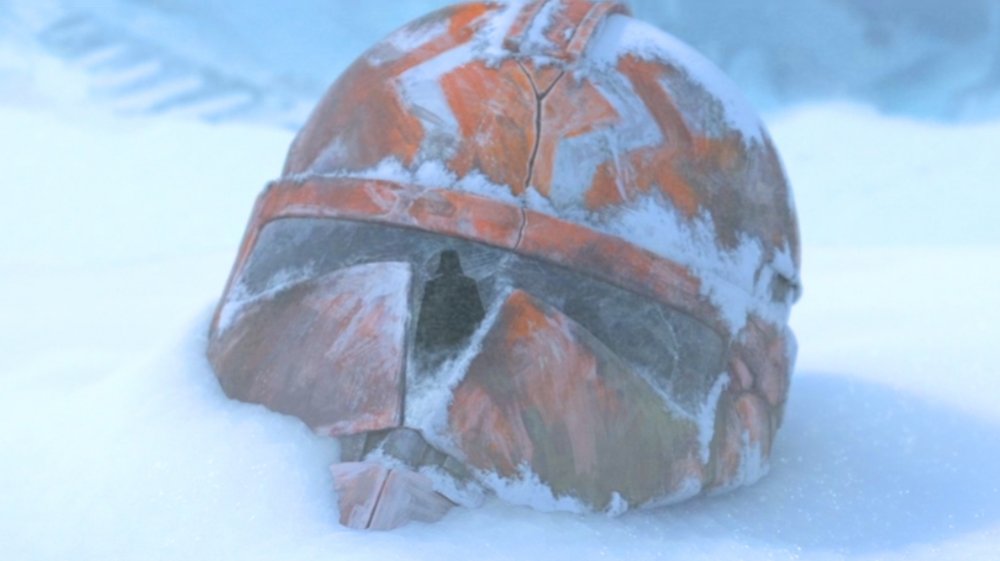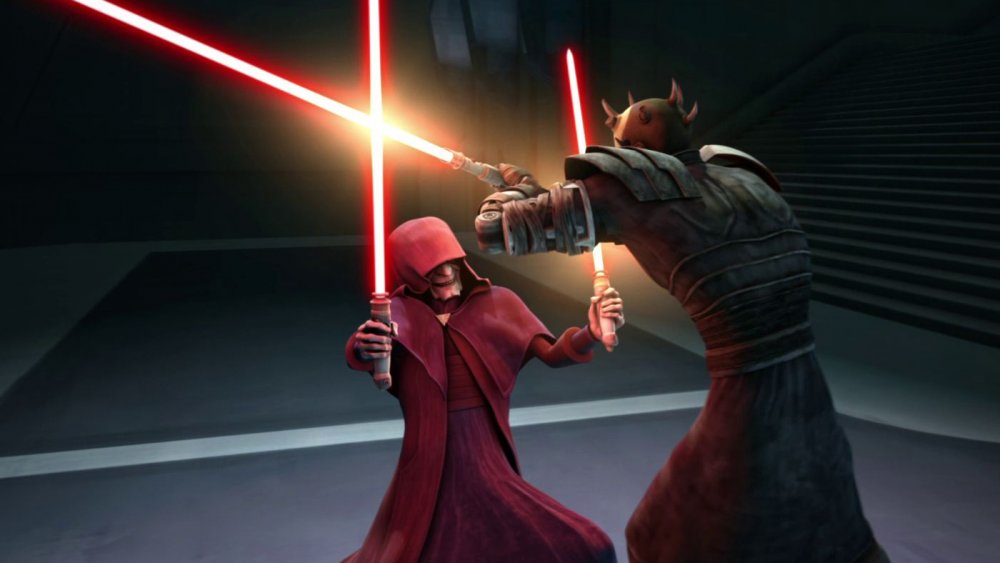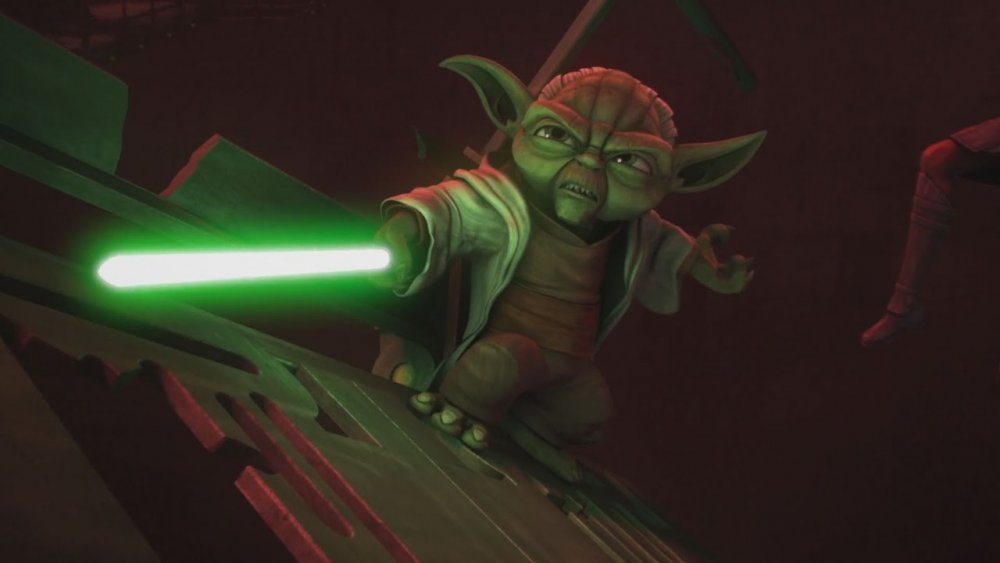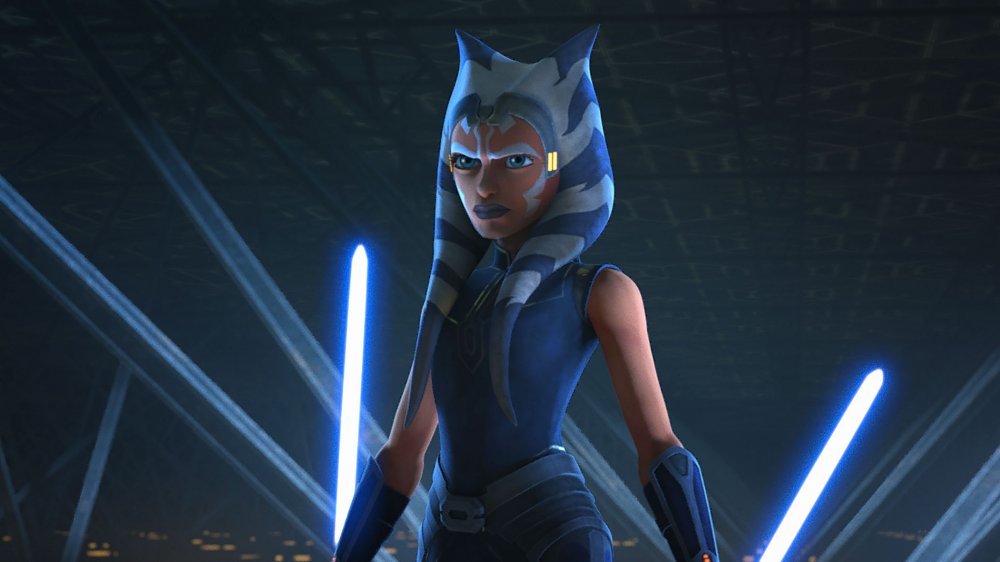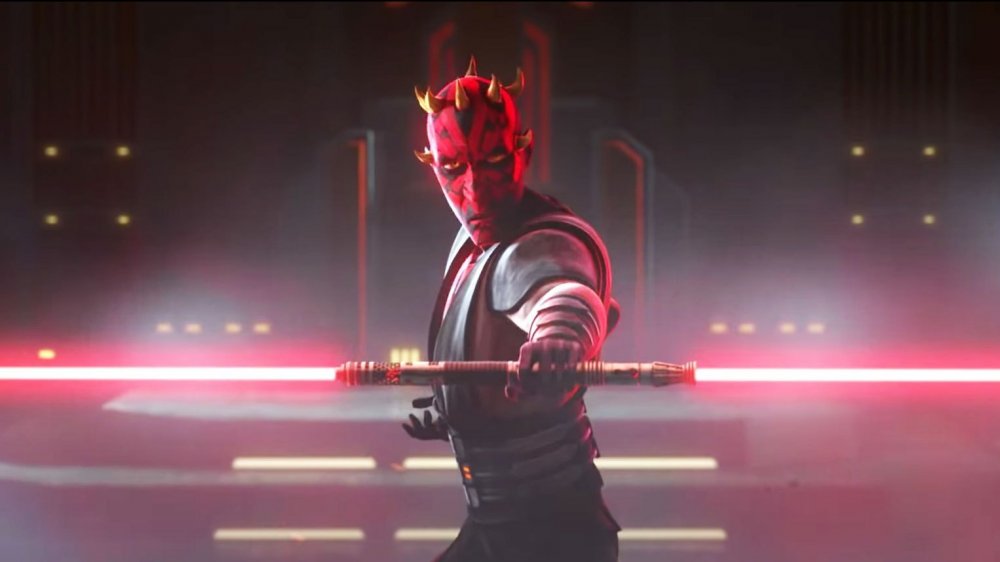Lucasfilm's Keith Kellogg Opens Up About Animating The Clone Wars' Final Season - Exclusive Interview
The Clone Wars is finally over, and it's safe to say that the final batch of episodes delivered everything fans wanted to see and more. From the epic lightsaber duel between Ahsoka and Maul to the chilling aftermath of Order 66, it's hard to imagine a better ending for Ahsoka, Rex, and the rest of the Clone Wars crew.
Keith Kellogg is a big part of what made the show's long-awaited final season so successful. As Lucasfilm's resident animation supervisor, Kellogg is the man in charge of defining how The Clone Wars moves, and has a direct hand in everything from the show's quieter (and, in this case, often heartbreaking) emotional moments to its high-adrenaline action scenes.
To commemorate the end of The Clone Wars, Kellogg took some time to speak with Looper about putting together this final season. During our interview, Kellogg shared memories of working with George Lucas, explained how The Clone Wars changed during its eight-year hiatus, and told us what it was like getting Ray Park back to play Darth Maul.
How Keith Kellogg got ready to visit a galaxy far, far away
What's your animation background like?
I went to the University of Massachusetts at Amherst. Basically, I was kind of fortunate in that even in high school I knew what I wanted to do. I liked art and I liked technology, and I'd just seen Jurassic Park and Toy Story and was like, "Oh my god, you can combine those two things? That's a possibility, to be able to do that?" So I kind of knew that I wanted to do that.
At the same time, I was also really big into tennis, so I ended up getting a scholarship for division one tennis at the University of Massachusetts. They also had an up and coming computer arts program, which there weren't many of at the time. Syracuse had a pretty good one and UMass had a pretty good one, so I decided to go there, because athletics and art don't usually mix too well. They're kind of different things. In my freshman year, I tore up my knee and ankle really badly and that ended my tennis, and I started really concentrating on the animation and computer aspect of it.
Out of school, I started work at Centropolis, which was Dean Devlin and Roland Emmerich VFX house. There I worked on The Patriot, Eight Legged Freaks, fun VFX movies. So, we did kind of that stuff, and then Centropolis was awarded the Matrix sequels. Our company, at the time, just wasn't ready for that. We were a smaller VFX company, and that's kind of what put Centropolis under, unfortunately.
We went out of business, and then I went over to Sony for about six years working on other VFX films and animated films and things. From there, I went on to work at IMD, which was ImageMovers Digital with Robert Zemeckis, for about five years, and then I finally moved down to Lucasfilm. It was 2009, 2010.
How did working on live-action films like the Matrix sequels or Narnia prepare you for Star Wars?
Coming from VFX and features, it was definitely a bit of a transition to come into TV, but I think that VFX and that kind of stuff really allows you to understand how much you have to dial stuff in and connect shots. In VFX, we sometimes have 20-plus takes of shots to go through before something finally gets approved. To transition from that into TV gave me a really good eye for knowing what to push and what not to, really being able to dial the episode down into parts like, "All right, I know we really need to hit this." These couple of shots tell the story. It's a droid going by, that's fine, but we really need to make sure the emotion comes across and meet these needs.
Do you have a favorite Clone Wars scene or sequence?
Man, that's a tough one. There's a lot of really good ones. I really liked the lightsaber battle we did with the Emperor, Maul and Savage. First, the Emperor basically killed Savage after they jump down hundreds of feet, and then Maul had to fight the Emperor.
Just the different styles, I think, was what I really loved about that. The Emperor had his own sort of style of fighting, and then you bring Maul with his flamboyant kind of showmanship, and then you had Savage, which was just power, with so much force behind every blow. They're all fighting with lightsabers, but to be able to bring the different styles and action and bring that all together so that each one was unique, was really, really, really cool.
The Maul, Ahsoka fight in Mandalore.... It's up there. It's really great. Hopefully that goes down as one of the best lightsaber fights that we've done.
Is there anything about Clone Wars that you're particularly proud of that you don't feel like has gotten the attention it should, or anything you want to say about the show that you haven't gotten a chance to yet?
I think that the main thing I'm super proud of is getting the opportunity to bring Clone Wars back, and really finish it the way that Dave envisioned it to be, and not be forced to kind of wrap it up. It had a rough start with the movie and everything, and then just slowly gained back that fanbase, and now when you hear Clone Wars, people are so stoked and so pumped about it. You see all these people dressing up, and going to that Comic-Con unveil of the trailer that we did, it was just... oh my god, that was so awesome, because nobody knew, and we knew we had this trailer, and nobody knew we were doing it. To hear the reaction was just unbelievable.
On the schedule we have, and with the budget that we have, I think the fact that we're able to pull off a show that looks the way it does, characters move the way they do, I think is just a testament to... We've had a lot of the same leadership in place all through the last eight to 10 years. We've all been working together, from Kilian Plunkett, who is our art designer, to Joel Aron, who's the VFX and lighting supervisor, to Paul Zinnes, who's the asset supervisor, to myself as the animation supervisor. That team, along with Dave obviously shepherding us all along, and Athena, who's been our producer, we always want the best in creating the best.
I think that, along with working with a partner like CGCG, has really enabled us to know when to push things, when to dial back, and how to create these great stories and have them look the way they look. I think, hopefully, we're remembered as being able to bring feature-quality animation to a television show, on a television budget. That was my goal when I first got to Lucasfilm Animation, to say, "All right, can we get to this feature-level quality on a television budget and produce great stories?"
What it was like working with George Lucas on The Clone Wars
You've worked on Clone Wars, but you've also done Rebels and Resistance. From an animator's perspective, what makes The Clone Wars unique among all the Star Wars animated series?
The way I always kind of describe it is Clone Wars is either 70-30 or 80-20 realism/animated. That's the sort of benchmark go for, whereas Rebels was like 60-40, sometimes even 50-50, where we pushed things a little more stylistically, pushed expressions and things a little more. Then, Resistance was on the opposite end, where it was more like 60-40, 70-30 the other way. We really went cartoony and pushed things. With Clone Wars, we really do focus on the subtlety and the nuance of things a lot more. We try to really kind of dial in more of that realism and real acting-type feel more than what we did on both Rebels and Resistance.
Why take that more realistic approach for Clone Wars?
With Clone Wars, it was always what George [Lucas] and Dave [Filoni] were pushing towards. Early on, we weren't quite able to get to that. I don't want to say we want to be realistic, because we really don't. We want to still maintain the fact that it's a stylistic show. George's whole idea was that at any one time, you could stop a frame and it would look like a comic book or a painting.
So, we still want to retain that idea, a lot of the angularity that's in the models and the look from when we first started. We definitely want to maintain that. We're just sort of trying to push the acting a little more towards more realistic acting, where it's real emotions coming across, not something you would find normally in any cartoon television show.
Did you work much with George Lucas directly during that initial run?
Initially? Yeah. George was definitely around quite a bit during that time, which was pretty amazing. It was pretty cool. He really wanted to see these stories told, and he brought along Dave Filoni to be his padawan, if you will, and really showed how he makes stories and films and TV shows. He would be involved in all the aspects from the script stage all the way up through our final story reel, before we sent it overseas to really be produced and animated. Then he would give us notes once he saw the final rendered version.
It was up to him if he liked certain things. We would make notes based on whatever he thought after reviewing it. That was actually really good, because he was coming at it after not seeing it for a while, so he had a different eye from us, who were really involved in it all through the production. He could look at it as a viewer and just sort of know, "Hey, this isn't working. This introduction does not really work for this character," or, "This story point we need to hone a little bit more." He was super involved at that point, which was really a pretty amazing and incredible experience.
What's the biggest storytelling lesson you learned from George Lucas?
George, even beyond cinema, he knows sound, he knows cinema, he knows all the different sort of types of visual mediums to tell a story. He really has shown us how to put characters on thirds, to make sure you have a wide establishing shot move into a more close-up view, all the classic sort of filmmaking techniques that we've been able to incorporate into the series.
How The Clone Wars changed after its long hiatus
On Rebels, you guys worked really hard to kind of capture the aesthetic of the original trilogy. Do you do kind of similar stuff on Clone Wars recapture sort of Lucas' look for the prequel trilogy?
I think Clone Wars, one of the big things you'll notice, and you'll really notice it in the newer episodes, is the camera work and the lens choice. They're much wider lenses, and it's much more sort of swoopy, moving cameras, which is much more what was done at the time of the prequels. On Rebels, for instance, we tried to maintain the feeling of cameras on sticks and only do camera moves that you could do at the time. When the prequels came around, CG was really big, and we were starting to get the feeling for these camera moves that necessarily couldn't really be done 100% on just a crane.
You can look at episodes like "The Citadel," for instance, where we fly in through these canyons and different things all the way up to our characters. We have a lot of what we call "oner" shots, where it's a very long shot, 30 to 50 seconds, and the choreography takes place throughout that, trying to go from one part of a battle to another to link up another character. Those, from an animation perspective, are incredibly difficult to try and get right, but our story team does a really amazing job of choreographing it out, figuring out where things are. We try and flesh it out and really put the character and the expression and the subtleties into it once we get it into animation.
It's been eight years since the last Clone Wars season. How has the animation process changed between the initial run and the Disney+ revival?
You know, it's interesting, because we were doing, I think, something that at the time, back in 2011, 2012, that really wasn't being done anywhere else, which was what George wanted us to do, which was use our proprietary tool. Through George's help creating it, we were able to create a really great storytelling tool that allowed our story artists to block scenes quickly, shoot with coverage, and then bring that into an editor and go through an editorial session where we could cut it and change it and manipulate it.
We shoot almost like live action in terms of trying to get coverage and be able to go from different areas and things, like over the shoulder shots, and then shoot the other over the shoulder, then your wide shot. You kind of do that, which isn't really something that's done in animation. We were doing that back in 2012, even 2010, and now we're doing the same thing. The tool has gotten a little bit better, with different sorts of enhancements.
I think from the animation side, the biggest change is just the technology. Our rigs are able to be a little bit more complex. Our modelers know a little bit more about how we can dial in and blend shapes and different things into our rigs. I think, just honing the animation skills of our overseas team over the years, they've gotten better and better. So, now we're able to produce something that looks hopefully better than it did earlier on.
That's one of the things that we've always strived to do with Clone Wars. We always wanted to try and make sure that this was the best-looking show on television in terms of computer animation, so we keep pushing the bar further and further. Hopefully what everyone sees, once they get to the Siege of Mandalore, is something that they're incredibly wowed by and knocked off their feet.
Did you have to create all new assets for the new season?
Yes, generally we did. We've been able to use some older assets, but we kind of had the same problem, I think, that they had when Toy Story 4 came out. There's been such a gap in terms of quality level that when we went back and looked at some of the stuff we did and how simplistic it is, and it was like, "Well, we need to up that." Originally, we thought we'd be able to share a lot more, but we usually do have to change or retrofit things, especially from the rigging standpoint. Every character had to be re-rigged, because we have this rigging standard that we use now that's different from what we used before.
What it was like bringing Ray Park back as Darth Maul for The Clone Wars' final arc
You mentioned the Siege of Mandalore. You had Ray Park come in to do motion capture for Darth Maul, right?
Yeah, that was so cool.
Had you done motion capture on Clone Wars before?
We did do motion capture during "Wookie Hunt." It was basically when the Wookiees were fighting the Trandoshans, and the Wookiees got up to their hang out, a hidden corridor and we had this big fight up there. We did use motion capture for that, because we wanted to try it out at the time. We ended up using some of it, we ended up throwing some of it out, because it kind of locked us in a little bit more than we wanted to be, but that was sort of our first foray on Clone Wars into using motion capture.
I obviously have a pretty big background in motion capture from working with Zemeckis, so it was interesting to try it, especially on our schedule and budget. It worked to a certain extent, but I think what we were able to do with getting Ray in there for Maul... Obviously, we've been animating Maul for a while. Every time we do, we really study the movies and what came before us, but we've had to create a lot of Maul, because he's in, I think, eight minutes of the movie. So, there's not a huge amount of stuff we can pull from.
Sam [Witwer] has done an amazing job with his voice, and we've been able to create this really amazing character now on Clone Wars. Maul lives as sort of this really great character with a really nice arc, going through Clone Wars up through Rebels, when you see him fight Obi-Wan.
For the fight, we were able to use Ray and see him deliver a choreographed scene of what we were looking for, and the subtlety and the nuance that he is able to bring to that. He is Darth Maul. So, being able to see that up close and see the moves that he's still doing, and certain ways he'll lift his leg, or he'll do a double jump, or the foot plant that he'll do, or little things like that that I certainly wouldn't have thought of in terms of what we would do in animation. To be able to get back in there and get his fierceness, and even the way he sort of stalks people when he's Maul, he'd sort of become this kind of predator, to be able to take that and add it to what we already have was really a pretty epic pairing.
Like I said, motion capture, for us, is not necessarily the easiest thing for us to incorporate into our pipeline. We don't really have the ability right now to do that with our rigs, so we really ended up using it as a guideline. We had video reference of it, and we were able to take it into our story package and use it. We used it as a reference.
Also, the other thing is, if we just left it as motion capture, it wouldn't really work with the Clone Wars style. We had to take that motion capture and put it back into our original style. There are faster moves, there are more holds whenever anything makes contact, so that you can read the pose. There are little extras, and they had to be a little bigger. Ahsoka had to be able to jump a little bit higher, she had to be able to do more of a flip.
So, we took it and then had to meld it into what we did. We actually did a little test, where we saw what it looked like with straight mo-cap, and it felt very odd to see that compared to everything else. So, there was definitely quite a bit of work to try and get it into the Clone Wars animation style so that it looked like exaggerated motion, not just physical motion from motion capture.
Do you use photo reference from the rest of the cast to inform characters' performances?
One thing that, when I first got there, I requested was the ability to record our voice actors. One of the reasons I wanted that was for how the mouth moves and how it works on certain syllables, because our animators are all overseas and 90 percent of them don't speak any English. It was really for them to be able to see how the jaw works and how they're forming the mouth. They're getting so much better. It's really impressive where they've come to, but the number of lip sync notes was just huge, because they don't speak the language. It's like me trying to animate French. I was like, "I don't know how you guys even get as close as you do." I don't know what I would do if I had to do that.
So that really gave us a starting point and a baseline. Some of the actors are not screen actors, they're just voiceover actors, so it doesn't really necessarily inform the actual acting performance. Some of them are screen actors, so we do use some of that stuff. I will also act out usually about a third of each episode and give that to our animators as a starting point for what I want to get in terms of the performances.
Because we have such a fast schedule, the sooner I can get stuff where we need it to be, then the better off we are. If they animate a shot and it's beautiful but it's not the right type of performance, we lose a lot of time on that and need to go back. So, the more sort of upfront work I can do, whether it's an animation kickoff where we go through each shot and talk about it and go through what we're looking for, or video reference, giving them a package to start with, and then letting them take that and run with it and be animators.
I think one of the biggest things about our show that works really well is the collaboration between us and CGCG. We've also worked with Sparx and we've worked with Lucasfilm Animation Singapore. I think one of the things that we try at Lucasfilm to do is really collaborate. We don't want to be dictators. They are the ones creating the ultimate, final thing. I want them to feel a part of it, and so in order for that to happen, they have to feel that they can express their art too. So together, I think that makes them a lot more invested in it.
It's amazing how invested they are in the characters and the things that they go through, even though Star Wars isn't something they grew up with. As they see the stories and things, they become invested in Ahsoka and what happens to her. They'll ask questions a lot, further episodes down the line, things like, "Oh my god, what's going to happen here?" So it's really kind of interesting.
